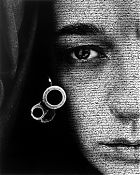She Who Tells a Story: A Window into the World of Female Photographers in the Middle East
The perception of Middle Eastern women by the rest of the world is challenged, dissected and put into context in an expansive new show at the Museum of Fine Arts, Boston, featuring twelve leading female photographers from Iran and the Arab world. Curated by Kristen Gresh, “She Who Tells a Story” focuses largely on women photographers from Iran, chronicling the work of Jananne Al-Ani, Boushra Almutawakel, Gohar Dashti, Rana El Nemr, Lalla Essaydi, Shadi Ghadirian, Tanya Habjouqa, Rula Halawani, Nermine Hammam, Rania Matar, Shirin Neshat and Newsha Tavakolian, and presented together in the United States for the first time.
Ranging from fine art photographs to documentary photography, the exhibition demystifies the Western stereotype of women living in the Middle East, removing the proverbial veil that art critics want to place on their work. Instead of categorizing the work as a sort of anthropological study of life in the Middle East, the exhibition defines each photographer as an artist, celebrating their perspective while giving each a creative voice to express it.
The Western perception of work from the Muslim countries in the Middle East is often boiled down to what the media feeds to the masses, giving an impersonal presentation of the issues at hand. This exhibition blasts through the controlled and calculated representation of life in the Middle East portrayed by the media, and instead gives insight to the actuality of political, social and familial issues faced each day, by the women who live it. Rather than a one-sided outsiders view, the photographs in this exhibition show that the complexity of dealing with these political and social issues can also bring beauty, solidarity and a journey to discover personal identity. The photographers exhibited are united under the realm of living in the Muslim world of the Middle East, but through the exhibition we are shown how each has carved her own niche and voice.
In reaction to dealing with the eight-year Iran-Iraq war, Dashti’s piece pushes beyond the images of war shown on television, and instead humanizes the reality of living in a war zone. Throughout the series, a couple is portrayed going through daily activities in a fictionalized battlefield, from hanging laundry to watching television, showing how everyday life still goes on amidst the horrors of war. In “Untitled #5,” the couple wears expressions of perseverance, showing the determination of the human spirit in a time of tragedy.
In the Western world, perhaps the most well known artist in the show is Shirin Neshat, whose signature gelatin silver prints mesh documentary style portraits of Iranian women with flowing text taken from poetry, religious books and scriptures. “Roja” is a contemporary portrait decorated with text from “The Book of Kinds,” a 1,000 year old epic poem by the famed Persian poet, Ferdowsi, a symbolic fusion of tradition with the present.

Shiring Neshat, Speechless, 1996.
Shirin Neshat, Roja, 2012. Photograph, gelatin silver print with India ink.
Shadi Ghadirian’s “Qajar” series shows the mesh of modernity and tradition in the Muslim world. The beautiful images are staged in a traditional studio setting of early historic photography, with sumptuous painted backdrops and printed in romantic sepia tones. Within each of the seemingly beautiful portraits, the women in question each hold a modern object that is common to the Western world, such as a newspaper, pair of sunglasses, or can of Pepsi. Surprisingly, each of the items shown is banned under the Iranian government, creating a visual relationship between the guise of tradition and the actual reality of restriction that the Iranian people face.
Rania Matar’s series “A Girl and Her Room,” creates a relatable juxtaposition between the Western and Arab world, by photographing the innocent teenagers in their bedrooms. The girls are shown reclining around stuffed animals, pin-up posters, and bottles of nail polish, in scenes that could be lifted from anywhere around the world. Matar’s choice to document teens for this series, (she has also photographed teenagers in the United States), gives a perspective that is untainted by the politics of society, as teenagers coming of age struggle to express themselves before social norms have fully taken hold affecting their notions of self.
“She Who Tells a Story” is a powerful exhibition that introduces the fine art world of the United States to a thriving collection of working female photographers from Iran and the Middle East. Within the context of a museum, the sensationalism associated with this part of the world in the media is left behind. The photographs are then on their own, and able to communicate a more personal, powerful message, reflecting the experiences of the artists, rather than the newspaper headlines often associated with the controversial events each woman lives through daily.